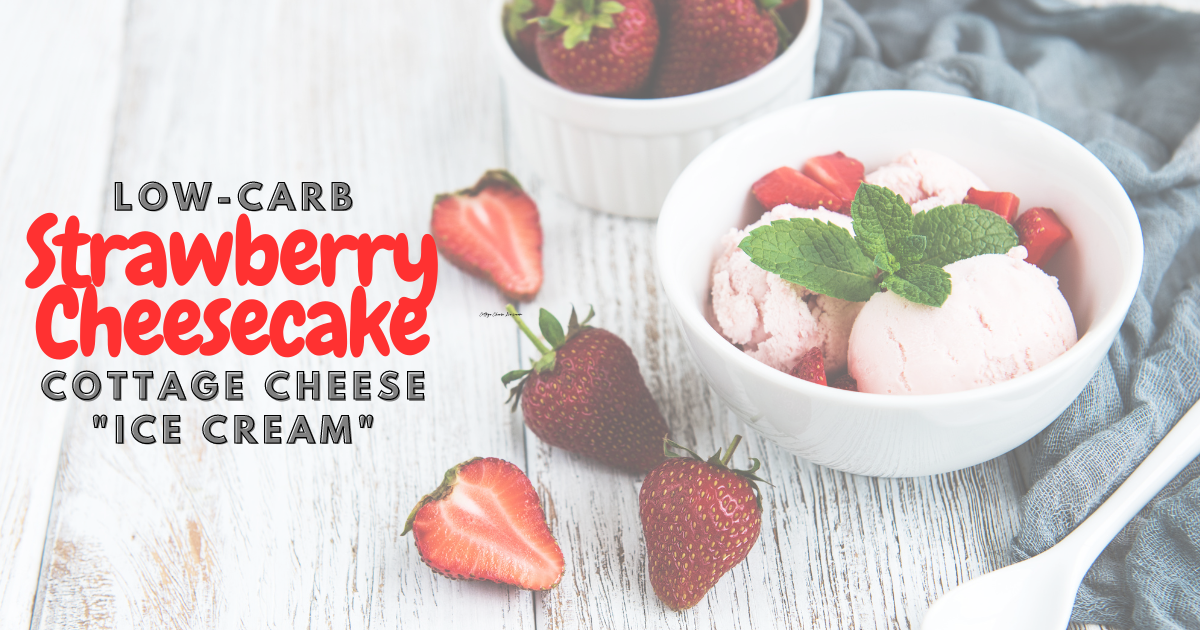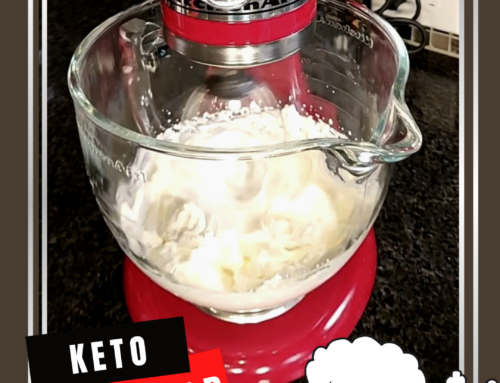Who says low-carb desserts can’t be delicious? This Low Carb Strawberry Cheesecake Ice Cream recipe proves that wrong! With its creamy cottage cheese and coconut milk base, this ice cream is sure to satisfy your sweet tooth without sabotaging your diet. And the fact that it’s low in carbs, high in protein, and low in calories makes it even more guilt-free!
The combination of the creamy ice cream and the tart strawberries is simply irresistible. And the best part about being able to make this at home is that you can mix it up to make so many different flavors and try different combinations!
To make my Strawberry Cheesecake version, you’ll need:
Ingredients:
- 1 cup cottage cheese, room temperature (full fat preferred)
- 1/2 cup coconut milk or heavy cream
- 1/4 cup erythritol (I prefer powdered)
- 1 teaspoon vanilla extract
- 1 cup fresh strawberries, chopped
- OPTIONAL: 1/4 cup Catalina Crunch Cinnamon Toast Cereal or OPTIONAL: Low-Carb Cheesecake pieces (see recipe here)
Directions:
- In a blender, combine the cottage cheese, heavy cream, erythritol, and vanilla extract. Blend until smooth.
- Then, add 1/2 cup of the strawberries and blend until smooth.
- Pour the mixture into a freezer-safe container and freeze for at least 4 hours, stirring every 30 minutes to prevent it from becoming too “icy.”
- About 30 minutes before serving, set out on the counter. When it’s soft enough, stir in the reaming chopped strawberries (if you prefer not to have chunks of strawberries, blend all of the strawberries into the original mixture) and 1/4 cup cinnamon cereal or cheesecake pieces (you can also place this in your bowl first or sprinkle on top rather than combining it in).
- Serve immediately or refreeze for later.
Helpful Tips:
Here are some tips for blending cottage cheese for ice cream:
- Use full-fat cottage cheese for the best flavor and texture.
- Let the cottage cheese come to room temperature for at least 30 minutes before blending.
- Blend the cottage cheese on high speed until it is smooth and creamy.
- If the cottage cheese is still lumpy, add a tablespoon of milk or cream and blend again.
Cottage cheese needs to be room temperature to blend smoothly and evenly in the ice cream mixture. If the cottage cheese is cold, it will be lumpy and difficult to blend. This is because the proteins in the cottage cheese will be more tightly packed together when they are cold. When the cottage cheese is brought to room temperature, the proteins relax and become more spread out, which makes them easier to blend.
In addition, room temperature cottage cheese will help to prevent the ice cream from becoming too icy. When ice cream is made with cold ingredients, the water molecules in the ingredients will form large ice crystals. These ice crystals can make the ice cream taste grainy and unpleasant. By using room temperature cottage cheese, you can help to prevent the formation of large ice crystals and create a smoother, creamier ice cream.
Other Helpful Tips:
- Incorporate flavors: You can blend in other ingredients for added flavor, or fold in chunks of additional toppings before freezing. For example, you could blend in chocolate or cocoa powder for chocolate ice cream. You could also add mixed berries, bananas, peanut butter, or nuts. You could also substitute the erythritol for dates, honey or maple! Try folding in brownies or cookies (low carb or not, the choice is yours). The possibilities are truly limitless.
- Let it soften: Cottage cheese can become icy when frozen, so let it soften on the counter before scooping. This will give you a cleaner, smoother scoop that tastes more like ice cream. Depending on the depth of your container, this can take up to 30 minutes. The longer you leave it in the freezer, the more time it will need to soften so keep that in mind when serving.
- Stir regularly: To prevent your cottage cheese ice cream from becoming icy, stir it every 30 minutes after you place it in the freezer. Cottage cheese has a lot of water, which will also freeze. This quick step will help keep it creamy.
- Think of “chilling”: Instead of freezing it completely, chill your cottage cheese ice cream until it’s thick and cold. This will make it creamier and less icy.
Nutritional Facts (approximate):
The nutritional facts are based on the recipe as written, with no substitutions. The actual nutritional content of your ice cream may vary depending on the ingredients you use.
- Serving size: 1/2 cup
- Calories: 150
- Fat: 10 grams
- Carbohydrates: 8 grams
- Sugar: 0 grams
- Sugar Alcohols: 4 grams
- Fiber: 2 grams
- Protein: 3 grams
Note: Sugar alcohols are not counted as total carbohydrates on food labels because they are not fully absorbed by the body and do not have the same impact on blood sugar levels. According to the FDA, sugar alcohols can be subtracted from the total carbohydrate content of a food, as long as they are listed on the ingredient label. So, in the case of this ice cream recipe, the total carbohydrate content would be 4 grams, even though there are 4 grams of sugar alcohols. The FDA allows this because sugar alcohols have a different metabolic effect than sugar. They are not digested by the body in the same way, and they do not raise blood sugar levels as much.
I hope you enjoy this delicious and refreshing Low Carb Strawberry Cheesecake Ice Cream recipe! If you have any variations that you love, please share them in the comments so that we can try them out, too!







Leave A Comment